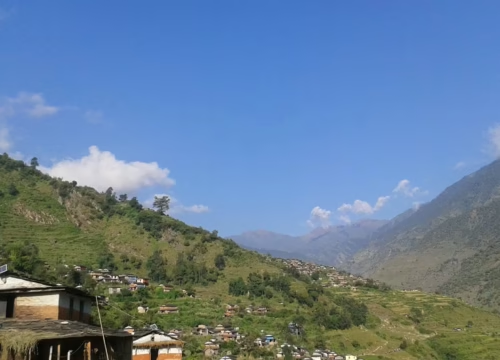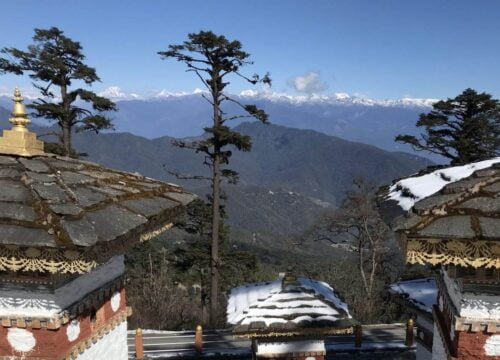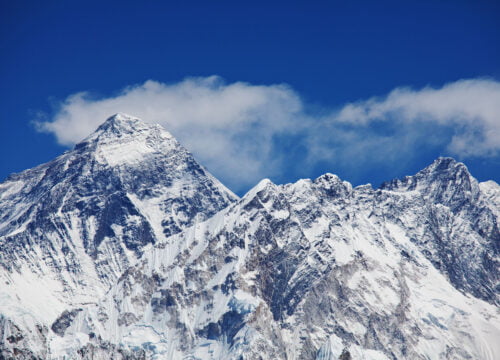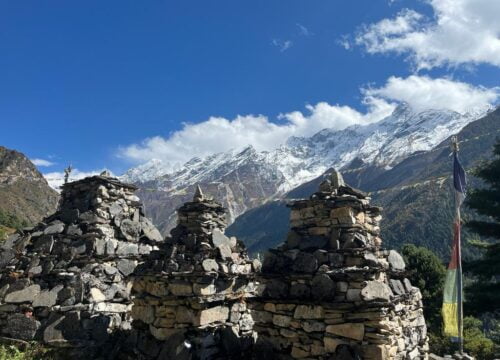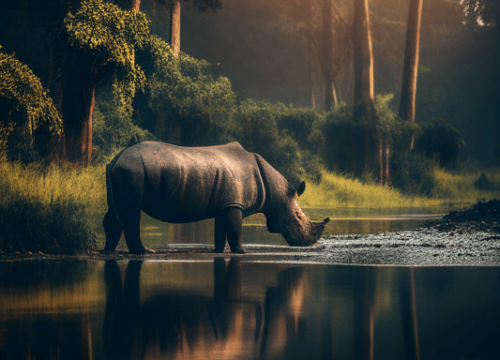Kathmandu City Tour (C)
Trip Overview
Embark on a captivating exploration of Kathmandu’s lesser-known treasures with our unique Kathmandu City Tour itinerary. This cultural adventure takes you beyond the usual tourist spots, delving into historic towns, traditional villages, and ancient cities brimming with cultural heritage.
Kirtipur: A Gem on Kathmandu’s Doorstep
Nestled atop a hilltop, Kirtipur boasts a rich Newari heritage. Marvel at architectural wonders like the Bagh Bhairav and Chilanchu Vihar temples. Discover the town’s fascinating history, including tales of valor and resilience during its resistance against the Gorkha kingdom.
Stepping Back in Time at Bungamati: A Traditional Stop on Your Kathmandu City Tour
Journey next to Bungamati, a traditional Newari village steeped in history dating back to the 6th century. Explore its narrow alleys lined with intricately carved wooden houses. Discover the majestic Rato Machhindranath Temple, revered as the protector of the valley. Pay homage at the Karya Binayak Temple dedicated to Lord Ganesh, and immerse yourself in the village’s vibrant cultural tapestry.
Unearthing Pharping’s Ancient Secrets: A Hidden Gem on the Kathmandu City Tour
Uncover the secrets of Pharping, an ancient city once known as “Shikarpuri Mahanagari,” a former sovereign state. Explore the Asura Cave, Gorakhnath Cave, and Sheshnarayan Cave, sacred sites of enlightenment for revered gurus. Immerse yourself in the tranquil ambiance of these historic caves and discover their spiritual significance.
A Cultural Odyssey Awaits on Your Kathmandu City Tour
The Kathmandu City Tour offers a captivating journey through the hidden gems of the Kathmandu Valley. Each destination, from Kirtipur’s rich heritage to Bungamati’s timeless traditions and Pharping’s ancient wonders, unveils a unique piece of Nepal’s cultural mosaic. Embark on this unforgettable odyssey and discover the diverse tapestry of history, spirituality, and tradition that defines Kathmandu’s lesser-explored corners. This comprehensive exploration promises to reveal the depth and diversity of Nepal’s cultural heritage while immersing you in the timeless charm of its hidden treasures.
Trip Itinerary
Depending on the number of guests, our guide will greet you in the lobby of your hotel and transport you to Kirtipur in a private car.
One of the earliest human settlements in the Kathmandu Valley was Kirtipur. According to records, Nepal's former capital was this little town. Kirtipur means "renowned town" in the Nepali language and is also known as "kipu" and "kyapu." This little town's position is distinctive from that of the other major settlements in the valley in that it is perched atop a precipitous, rocky slope. The Newars, the earliest residents in the valley, with their language, cultural norms, and values, reside in and rule over this city of splendor.
Just 5 kilometers separate Kirtipur Municipality, which is a part of the Kathmandu District, and Kathmandu. It is situated in a steep area. Kirtipur is located between the latitudes 85 13' and 85 19' N and the longitudes 27 38' 30" and 27 41' 30" E, with an elevation between 1284 m and 1524 m above mean sea level. The elevation generally drops from southwest to northeast. On the northern side is the Kathmandu Metropolitan City, while on the eastern side, the Bagmati River divides the Lalitpur District from the Lalitpur Sub-Metropolitan City. Both Machhegaun VDC and Kirtipur Municipality share a boundary with Chalnakhel VDC.
Kirtipur, which was once a Newari foundation, is without a doubt still a major hub for Newari culture. Along with neighboring villages, it now makes up Kirtipur Municipality. But now, individuals from many classes and religions reside here. As a result, there are several churches, gumbas, and temples there as well.
After paying off the city's doorman on his third try, King Prithvi Narayan Shah annexed it in 1826 B.S. to the Gorkha kingdom of Nepal. He then chopped off the noses of every man in the city to spite Kirtipur. The village's history dates back to the 12th century, when it was a Patan outpost until it eventually became its kingdom. In the massive revolt that ousted the king's authority in 2006, the people held an inspiring nonviolent protest here.
Due to its unhappy past with the Shah dynasty, whose contemporary founder insultingly captured the city, and the subsequent neglect of the administration and growth by succeeding rulers, it is regarded as an anti-monarchy city. Together with seeing the area, you may visit various intriguing temples like Bagh Bhairav, Chlanchu Vihar, etc. A significant pilgrimage site for Nepalese people is the temple dedicated to the goddess Dakshina Kali, which is located further from Kirtipur. It is possible to combine a trip to Kirtipur with trips to Chovar and Panga.
In the Bagmati Zone in central Nepal's Lalitpur District, there is a village development committee called Bungamati. A typical Newa settlement from the sixth century, Bungamati or Bunga (as locals refer to it in the Newa (Nepal Bhasa) language) or Amarapur (an older name), is named. The earliest reference to Kailashkut Bhawan was found on the first stele of Amshuverma, which was discovered in Bungamati and dated to Sambat 29 or 605 AD. The stele further demonstrates that Bungamati was already a well-known community for farming, raising animals, and fishing.
The village's name was Bugayumi during the Licchavi era and Bungapattan during the Malla era. It is located above the Bagmati River on a point of land. Rato Machhindranath, who is considered the protector of the valley and was born in Bungamati, spends six months of the year living in a Shikhar-style temple in the middle of the village square (he spends the rest of his time in Patan). He had to be transported through Patan and back and forth to Bungamati Central for one of the valley's most significant yearly events.
One of the most picturesque chowks in the valley is located near the temple; it serves as the center of a bustling Newa village. The Karya Binayak temple, which is devoted to Ganesh and located near Bungamati, is one of the most significant temples in Nepal. The Karya Binayak, which is encircled by trees and big bamboo and may gaze at the Bagmati valley to the foothills, has a magnificent view.
The Temple of Machindranath stands as Bungamati's primary ritual focal point. The name "Bungadeya" is how the villagers refer to Machhindranath; it is either derived from the village founded at the location where Bhairav howled "bu" (birthplace) or from the word "Bungaa," which means "watering place" or "spring," as the explanation of the village's name; several residents in Bungamati suggest the latter derivation. Water is associated with Bungadeya in several significant mythical, historical, and modern ceremonial contexts. An ancient rain deity named Bungadeya was later linked to the kind Aryavalokitesvara.
Machhindranath is also referred to as "Karunamaya," which means a mother-like incarnation of compassion and mercy. In contrast to Bungamati Newa, which uses the name Bungadeya to refer to Machindranath, other portions of the valley's Newah use the name Karunamaya. It is well known that Machhendranath is also Padmapani, Lokeshvara, and Aryavalokitesvara. The living goddess Kumari is a significant component of Bungamati's historical significance. Most people are only aware of Kathmandu, Patan, and Bhaktapur as the three kumaris, however, Patan also has a live goddess kumari in Lalitpur bungamati, close to where the important Rato Machhindranath and Karyabinayak (Ganesh) temples are.
The southern part of Kathmandu is home to the historic city of Pharping. It gained popularity under the moniker "Shikarpuri Mahanagari (Metropolitan City)," which was known in antiquity as a 48000-person sovereign state. Hence, "Shikrapur" is a historical name for the settlement of Pharping. Gopeshwar Temple was located in the center of Pharping when Shikrapur was a separate Newari polity. While Kathmandu Valley was a lake during the time, it was already a developed state. Lalitpur, Bhaktapur, and Kathmandu allegedly did not exist.
Then, the water of the valley began to flow outside as Goddess Manjushree carved out the Chovar gorge. The valley then turned out to be a good place to stay. As a result, Pharping has a long history, which is why it is regarded as the village's history. The renowned gurus of Buddhism and Hinduism are reported to have attained enlightenment in Pharping. It is renowned for being a holy location. For instance, the Asura Cave, Gorakhnath, and Sheshnarayan Cave in Pharping are where the Great Guru Padmasambhava attained enlightenment. Buddhist pilgrimages also frequently travel to this significant sacred site.
Until 2017 BS, Pharping village was a part of Lalitpur District. Pharping has arrived in the Kathmandu District. It is designated as Electoral Area No. 10 and Area No. 15 of the Kathmandu District Development Committee. Pharping is located on the Kathmandu District's edge. Makawanpur is to the south and west, Lalitpur District is to the east, and Kirtipur Municipality is to the north. It is a thriving city.
Sheshnarayan, Chalnakhel, Setidevi, Dakshinkali, Talku Dundechaur, and Chhaimale are the six VDCs that make up this region. Pharping has a population of around 40.000. The population of Pharping is diverse and comprises Newar, Brahmin, Chhetri, Tamang, Magar, Rai, Gurung, and so-called Dalits, among others. The settlement of Pharping is a typical Newari one. This entire hamlet is based on the language, culture, and history of the Newari people.
FAQs


